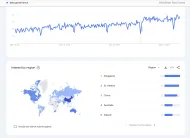Data Science
Inverse Reinforcement Learning: Use Cases & Examples
Inverse reinforcement learning is an approach in machine learning where machines infer the goals or reward structures that guide an expert’s behavior by observing their actions rather than receiving explicit instructions. Discover what inverse reinforcement learning is, how it works, and the top industry use cases with examples.
Top No-Code ML Platforms: ChatGPT Alternatives in 2025
We benchmarked 4 no-code machine learning platforms across key metrics: data processing (handling missing values, outliers), model setup and ease of use, accuracy metrics output, availability of visualizations, and any major limitations or notes observed during testing.
Top 5 RLHF Platforms & Features Comparison in 2025
As AI adoption grows, with 65% of organizations now regularly using generative AI, selecting the right tools for optimizing AI models has become more crucial than ever. Reinforcement learning from human feedback (RLHF) platforms have emerged as key players in this process.
Toloka AI Review & Its Top Alternatives for RLHF in 2025
Toloka AI is a popular name in the Reinforcement Learning from Human Feedback (RLHF) and AI data services spaces. If your business is considering an RLHF or AI data partner like Toloka AI, our research can provide valuable guidance.
![Applying RLHF: Techniques, use cases, and challenges ['25]](https://research.aimultiple.com/wp-content/uploads/trends/rlhf-6762ab510a995-190x128.png.webp)
Applying RLHF: Techniques, use cases, and challenges ['25]
Training AI systems to align with human values can be a challenge in machine learning. To mitigate this, developers are advancing AI through reinforcement learning (RL), allowing systems to learn from their actions. A notable trend in RL is Reinforcement Learning from Human Feedback (RLHF), which combines human insights with algorithms for efficient AI training.
Machine Learning in Data Integration: 8 Use Cases & Challenges
Integrating and analyzing data from disparate sources effectively has become paramount. Data integration often presents challenges, ranging from managing AI data quality to ensuring security. As organizations grapple with these obstacles, Artificial Intelligence (AI) and Machine Learning (ML) are emerging as transformative technologies, offering innovative solutions to simplify and enhance data integration processes.

Guide To Machine Learning Data Governance in 2025
In this article, we explain machine learning data governance. We explain its key principles, benefits, use cases, best practices, and our future expectations of data governance.
BI Governance: 6 Implementation Best Practices in 2025
The global business intelligence market is projected to be $33.3B by 2025, with more business units adopting BI tools. The importance of business intelligence is increasing. Data-driven decision making, for instance, is five times faster via data access and data analytics.
Multimodal Learning: How It Works & Real-Life Examples
Multimodal AI combines text, speech, and visual data to generate more comprehensive and accurate insights than traditional single-source models. This enables breakthroughs in areas like diagnostics, customer experience, and education. However, its impact depends on data quality, infrastructure readiness, and strategic fit.
30 Datasets for ML & AI Models in 2025
Data is required to leverage or build generative AI or conversational AI solutions. You can use existing datasets available on the market or hire a data collection service. Explore different types of existing datasets: custom human-generated, custom machine-generated, natural language processing, open, public government, image, audio, and healthcare datasets to train your machine-learning models.